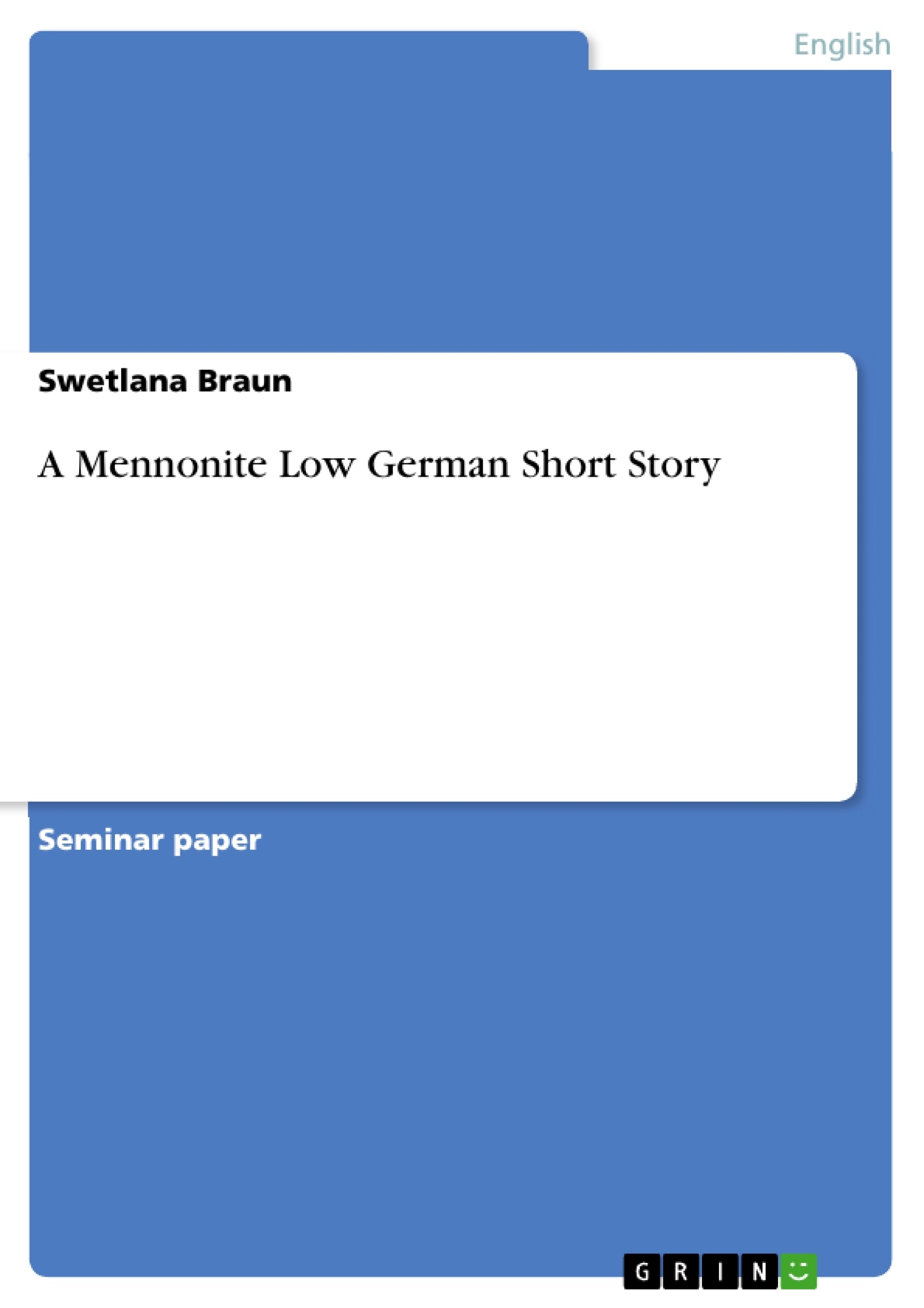The approach of this paper is it to present the Mennonite Low German dialect and to develop an easily intelligible orthography for the mentioned dialect. In the first point the roots of the Low German dialect under examination are highlighted and it is shown that it belongs to the same family as the English language. Both varieties belong to the Indo-European languages or, more precisely, to its West-Germanic branch. Then, point two explains where the term Mennonite Low German comes from by unrolling the history of the Mennonites, their moves and their linguistic history. In terms of definition there is a further question that has to be tackled, namely whether Mennonite Low German is a language or a dialect. This question will be discussed in point three, bearing in mind the four criteria Petyt names to decide whether a variety is a language or a dialect.
After having explained and linguistically discussed the term Mennonite Low German, I present my grandmother’s short story and use it to develop Mennonite Low German orthography, which will be expounded in the fifth paragraph. The mentioned paragraph is subdivided into four points, of which the first one discusses Mennonite Low German orthography, its tries and problems. As most of the Mennonite Low German speakers are familiar with High German (but not with other Low German dialects), the Mennonite Low German orthography presented in this paper will follow several characteristics of German orthography, when considered as useful. Moreover, a short sketch of Mennonite Low German phonology and morphology will be provided in the following subparagraph in order to round off the topic. A short overview of the variations of the dialect under examination can be found in point 5.3; namely the Molotschna and the Old Colony accents. The last subparagraph deals with Mennonite Low German loan words and recent word formation. This variety contains several loan words that come from Dutch, Russian or German, for example. Paragraph number six explains the death of a former Lingua Franca, which Low German had been at the time of the Hanseatic League. The decline of Low German might also explain the underestimation of its dialect Mennonite Low German.
Inhaltsverzeichnis (Table of Contents)
- I Introduction
- II A Mennonite Low German Short Story
- 1. Mennonite Low German and English: Members of the Same Family
- 2. Who are the Mennonites and what is Mennonite Low German?
- 3. Language or dialect?
- 4. A Short Story from my Grandmother
- 5. Mennonite Low German Orthography
- 5.1 Discussing Mennonite Low German Orthography, its Tries and Problems
- 5.2 Phonology & Morphology
- 5.3 Varieties of Mennonite Low German
- 5.4 Loan Words
- 6. The Death of a Former Lingua Franca
- III Conclusion
Zielsetzung und Themenschwerpunkte (Objectives and Key Themes)
This paper aims to present the Mennonite Low German dialect and develop an easily understandable orthography for it. It explores the historical and linguistic roots of the dialect, its relationship to English, and its unique characteristics. The paper also analyzes the challenges faced by Mennonites in reading and writing their vernacular due to the lack of a standardized orthography.
- The historical and linguistic relationship between Mennonite Low German and English.
- The history and cultural background of the Mennonite community and its impact on their language.
- The challenges of establishing a standardized orthography for Mennonite Low German.
- The analysis of a short story written in Mennonite Low German.
- The exploration of phonology, morphology, and loan words in Mennonite Low German.
Zusammenfassung der Kapitel (Chapter Summaries)
- I Introduction: This introductory chapter sets the stage for the paper by explaining the author's motivation for studying Mennonite Low German and highlighting the lack of a standardized orthography for this dialect. It also outlines the paper's main objectives and research approach.
- II A Mennonite Low German Short Story: This chapter delves into the linguistic family tree of Mennonite Low German, demonstrating its relationship to English and other Germanic languages. It also explores the history of the Mennonite community and their linguistic evolution, shedding light on the origins of the dialect. The chapter then addresses the question of whether Mennonite Low German is a language or a dialect, applying criteria to differentiate between the two. The chapter concludes with a presentation of a short story written in Mennonite Low German, serving as a basis for developing a new orthography for the dialect.
Schlüsselwörter (Keywords)
This paper focuses on the unique linguistic features of Mennonite Low German, including its historical development, orthography, phonology, morphology, and loan words. It highlights the challenges faced by Mennonite speakers in reading and writing their native language due to the lack of a standardized orthography. The paper explores the linguistic relationship between Mennonite Low German and English, drawing on comparative linguistics to understand their shared ancestry and unique development.
- Quote paper
- Swetlana Braun (Author), 2007, A Mennonite Low German Short Story, Munich, GRIN Verlag, https://www.grin.com/document/91792



